Network Stream Endpoint Continuous Streaming With No Disconnection Labview
The following sections describe the details of the general steps outlined in the section above, as well as performance considerations that you should take into account when designing and implementing your application.
Endpoint URLs
LabVIEW identifies each stream endpoint with a URL. To connect two endpoints and create a valid network stream, you must specify the URL of a remote endpoint with the Create Network Stream Endpoint Reader or Create Network Stream Endpoint Writer function. More detailed information on endpoint URLs, including escape codes for reserved characters, can be found in the LabVIEW Help under the topic Specifying Network Stream Endpoint URLs. However, for completeness, a brief description of URLs will be presented here as well.
The full URL of a stream endpoint is as follows:
ni.dex://host_name:context_name/endpoint_name
The following list describes the different components of this URL:
- ni.dex is the protocol of the URL and is optional. If you do not specify ni.dex with the create functions, LabVIEW will infer this protocol.
- host_name is the project alias, DNS name, or IP address of the computer on which the endpoint resides. In addition, the string "localhost" can be used as a pseudonym for the computer on which the code is currently executing. If host_name is left blank, localhost is inferred. LabVIEW searches for a matching host name in the following order: Project alias, DNS name, and then IP address.
- context_name is the name that identifies which application context the endpoint resides in. This is only necessary if the network streams feature is being used by multiple application instances on the same computer. By default, the context name is an empty string and all endpoints are created in the default context. When using the default context, you can omit the colon separator.
- endpoint_name is the actual name of the stream endpoint. This name can be a flat string or a hierarchical path of strings separated by the forward slash character. For example, stream 1 or Subsystem A/stream 1.
The URLs you must specify with the create endpoint functions will vary depending on the network location of the remote machine and the name you assign to the endpoint when you create it.
Creating Endpoints and Establishing a Stream
A network stream is the connection between a writer and reader endpoint. You create an endpoint using either the Create Network Stream Writer Endpoint or Create Network Stream Reader Endpoint function.

Creating an endpoint sets several properties on the endpoint that are important when establishing a stream that connects the two endpoints:
- Direction of the endpoint
- Name of the endpoint
- Data type
The direction of the endpoint is implicitly determined by which create function is called and can either be read only or write only. The endpoint name is supplied through the writer name or reader name input to the create function. LabVIEW uses this name to generate a URL for identifying the endpoint resource and must be unique. If an endpoint with the given name already exists, the create function will return an error. The name can be a simple string or a fully compliant URL. Refer to the URL section for more information on what constitutes a valid endpoint URL. While you can connect to existing endpoints that reside on remote machines, you can't create remote endpoints. You can only create endpoints on the local machine on which the VI is executing.
Unlike TCP, networks streams directly support transmission of LabVIEW data without having to flatten and unflatten the data to and from a string. Most LabVIEW data types are directly supported by network streams. However, a few notable exceptions include data types that contain object references or LabVIEW Classes as part of their type. Classes can still be transferred indirectly by first creating conversion methods on the class to serialize and de-serialize the appropriate class data. Since references are tokens that refer to objects on the local machine, it generally doesn't make sense to try and send the reference token across the network to be used by a remote computer. The one exception to this is the Vision Image Data Type, which is available if the NI Vision Development Module is installed. In this case, transfer of image data is directly supported by the stream through the use of a reference to the Vision Image Data. Any data types not directly supported by the stream will require conversion code to convert the data to and from one of the supported types. In addition, some data types are more efficient than others to transfer through the stream. See the Performance Considerations section for more information on how the chosen data type can impact the performance of the stream.
In addition to creating the endpoint resources, the create function also links the writer and reader endpoints together to form a fully functioning stream. The endpoint that is created first will wait until the other endpoint has been created and is ready to connect, at which point both create functions will exit. The stream is then ready to transfer data. Used in this manner, the create function effectively acts as a network rendezvous where neither create function will progress until both sides of the stream are ready or until the create call times out.
In order to establish a stream between the two endpoints, three conditions must be satisfied.
1. Both endpoints must exist. In addition, if both create functions specify the remote endpoint URL they are linking against, both URLs must match the endpoints being linked.
2. The data type of the two endpoints must match.
3. One of the endpoints must be a write only endpoint, and the other endpoint must be a read only endpoint.
If condition one isn't initially satisfied upon executing the create function, it will wait until the timeout expires, and then return a timeout error if the condition still hasn't been satisfied. If both endpoints specify the other endpoint to link against and only one of the URLs match, one create function will return an error, and the other will continue to wait until the timeout expires.
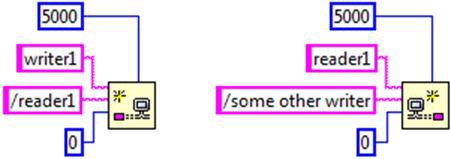
For instance, in the above example, the create call on the left will return an error since the "reader1" endpoint is expecting to communicate with an endpoint named "some other writer" and not "writer1". However, the create call on the right will continue to wait until the timeout expires for an endpoint named "some other writer" before returning a timeout error. If conditions two or three aren't met, the create function will return an error as soon as it determines the configuration of the two endpoints isn't compatible for forming a stream.
When creating endpoints, keep in mind that at least one of the create endpoint functions needs to specify the URL of the other endpoint in either the reader url or writer url input. Failure to do so will guarantee that both create calls will eventually return a timeout error. The reader and writer endpoints can both specify each other's URLs in their create function, but only one is necessary. In order to develop more portable and maintainable code, National Instruments recommends that only the reader or the writer specify the URL of the other endpoint, but not both.
Endpoint Buffers
Stream endpoints use a FIFO buffer to transfer data from one endpoint to the other. The buffer size is specified at the time of creation, and the buffer is allocated as part of the create call. The size of the buffer is specified in units of elements, where an element in the buffer represents a single value of the type specified by the data type of the stream. Therefore, the total amount of memory consumed by the endpoint will vary depending on the buffer size and the data type of the stream.
For scalar data types like Booleans and numerics, the amount of memory consumed by the endpoint buffer is easy to calculate since the size of a scalar data type is a fixed quantity that is known ahead of time. For instance, a buffer of 1,000 elements of double precision floating point numbers will consume 8,000 bytes of memory since a double precision floating point number always consumes 8 bytes of memory.
On the other hand, the amount of memory consumed when dealing with non-scalar data types such as clusters, strings, and arrays isn't as straightforward. The size of these data types can vary at runtime, so the total amount of memory required isn't known when the endpoint is created. In these cases, the buffer allocated when creating the endpoint is only large enough for each element to hold a pointer or handle to a data value written to that element in the buffer. The memory required to store each element's data value is then allocated dynamically at runtime as elements are written to the buffer. The image below helps illustrate this concept for a stream endpoint with a buffer size of three and an element data type of 1D array.
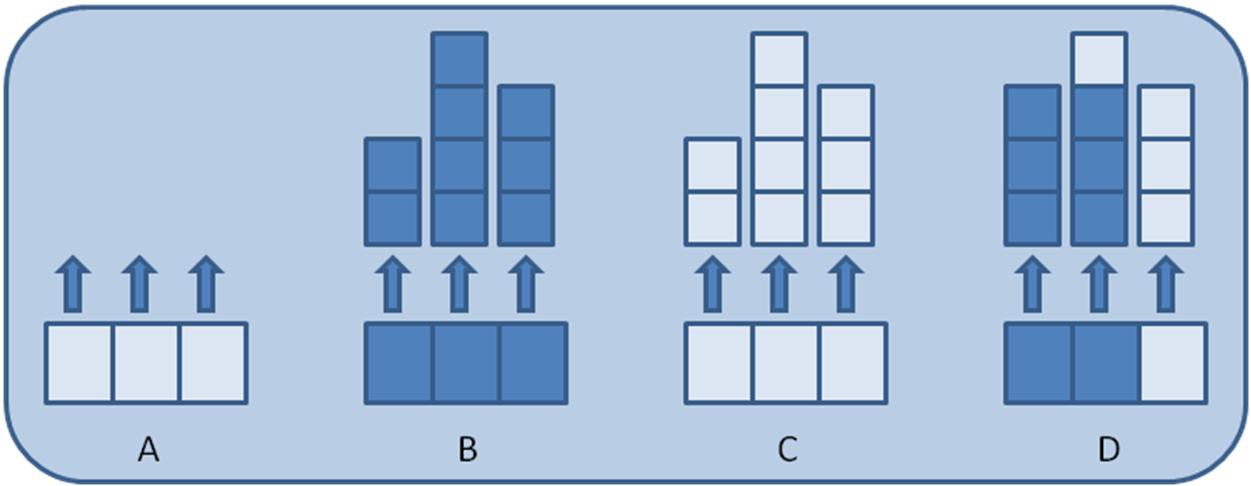
Step A shows the endpoint buffer immediately after creation. At this point, no data values have been written to the endpoint, and each element has been allocated enough memory to store a pointer that will point to the memory block containing the data value for that element.
Step B shows the endpoint buffer after three data values have been written to the buffer. Element 1 contains an array of length two. Element 2 contains an array of length four. Finally, element 3 contains an array of length three. Because this was the first write into the buffer, each write dynamically allocated a block of memory large enough to hold each data value.
Step C shows the endpoint buffer after all three data values have been read from the buffer. Note that even though all values have been read from the buffer, the memory allocated for each data value is not relinquished. Instead, the memory space remains so it can be reused for storing the next data value at that location in the buffer.
Step D shows the endpoint buffer after two more data values of length three have been written. In this case, the memory block maintained by element 1 wasn't large enough to hold the new data value, and a larger memory block had to be allocated. In contrast, the memory block maintained by element 2 was large enough to hold the new data value and was reused. Notice that even though the memory block maintained by element 2 was larger than needed, it was still reused rather than incurring the execution overhead of de-allocating it and allocating a new block that is of the exact size needed. Once a memory block is allocated for an element, it isn't relinquished or reduced in size until the endpoint is destroyed.
As this process illustrates, you must choose endpoint buffer sizes carefully for non-scalar data types. If the data elements are large and the buffer size is large, the endpoint may consume large quantities of memory until the endpoint is destroyed. This is also true for scalar data types. However, debugging out of memory issues with scalar data types is typically much easier since all of the required memory is allocated at once when creating the endpoint. In contrast, most of the memory required for non-scalar types is allocated as the buffer is filled for the first time. This can often appear as a memory leak since the application may run successfully for a period of time before running out of memory as the endpoint buffer is filled.
Reading and Writing Data
All read and write calls on the stream are blocking calls that are transactional in nature. They either read or write the requested number of elements successfully, or they time out. In the case of a timeout, no partial data is read or written, and data is never overwritten or regenerated. If a read call results in a timeout, the data out terminal will return the default value for the configured data type. This has the implication that the maximum number of elements that can be read or written in a single call is limited by the endpoint buffer size. A request to read or write a number of elements that is larger than the endpoint buffer size will immediately result in an error.

Network streams offer both single element and multiple element interfaces when reading and writing data. Single element reads and writes allow one element at a time to be added or removed from the buffer, while multiple element reads and writes allow data to be added or removed in batches. When using the different types of reads and writes, the representation of the data on the block diagram will be different. In the example below, the data type of the stream is a double precision floating point number. Writing to the stream using the single element write is represented on the block diagram by a data type of double. On the other hand, the data type for the multiple element write data in terminal is represented by an array of doubles.
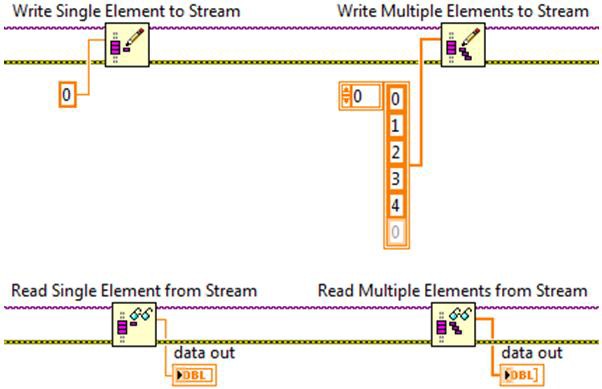
The figures below further illustrate this difference. The elements on the left of the arrow represent the writer endpoint buffer before the write operation occurs, and the elements to the right of the arrow represent the writer endpoint buffer after the write has executed. If the writer endpoint buffer initially has two elements, the execution of the single element write will add one element to the buffer and bring the total number of elements in the buffer to three. If the write multiple elements to stream function is used instead to write three elements, the total number of elements in the buffer will be five.


For non-scalar data types, such as arrays, the figures above look the same, but the contents of the individual elements are array types, which can have varying lengths. In this case, the data type for the single element write is a 1D array, and the data type for the multiple element write is a 2D array. This is illustrated in the figures below where the up arrows and the blocks above them represent the arrays and their respective sizes.
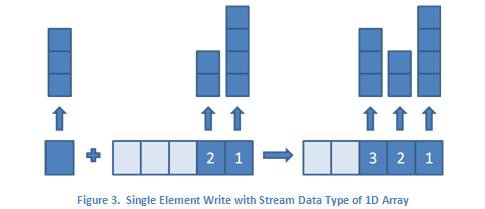
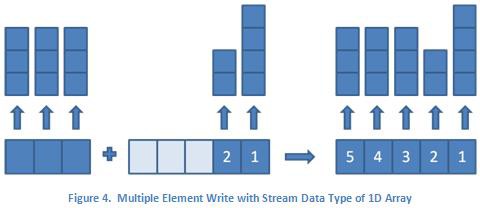
Similarly, the multiple element read will remove as many elements as are specified from the reader endpoint buffer. However, due to the limitations of multi-dimensional array structures in LabVIEW, all of the array elements must have the same dimension lengths. For multiple element reads, this means an error will be returned from the read function if an attempt is made to read multiple elements where the dimension lengths of any of the array elements differ. Using Figure 4 as an example, this means you can successfully read the first element in a single read call, the second element in a single read call, and the third through fifth elements in a single read call. However, any read call that tries to read any combination of the first through third elements will return an error since the dimension lengths of the array elements differ. Since the single and multiple element reads and writes are removing and adding elements from the same buffer, multi-rate applications can mix and match the use of single and multiple element reads and writes as necessary.
When using the multiple elements read function, a value of -1 for the # elements input means read all available samples.

This is equivalent to reading the Available Elements for Reading property and using the returned value as the input for the # elements input to the read function and is a short hand way of accomplishing the same thing. When used in this manner, the timeout in ms input to the read function is effectively disabled. If there are no available elements for reading, the read function will immediately return an empty data array without indicating a timeout or error condition.
Shutting Down a Stream
When you no longer need to stream data between the endpoints, you can cease communication from either endpoint by calling the Destroy Stream Endpoint function.

However, if you want to ensure that all data written to the stream has been received by the reader before destroying the writer endpoint, you must first call the Flush Stream function and wait for the appropriate wait condition to be satisfied before destroying the writer endpoint. Only writer endpoints may call the flush function.

The flush function first requests that any data still residing in the writer endpoint buffer be immediately transferred across the network. It then waits until either the specified wait condition has been met or the timeout expires. The Flush Stream function has two different wait conditions:
- All Elements Read from Stream
- All Elements Available for Reading
When you specify "All Elements Read from Stream," the flush function will wait until all data has been transferred to the reader endpoint and all data has been read from the reader endpoint before returning. The "All Elements Available for Reading" option will wait until all data has been transferred to the reader endpoint, but it will not wait until all data has been read from the reader endpoint. Using the diagram below as a guide, the "All Elements Available for Reading" option will return from the flush call after step C, and the "All Elements Read from Stream" option will return after step D.
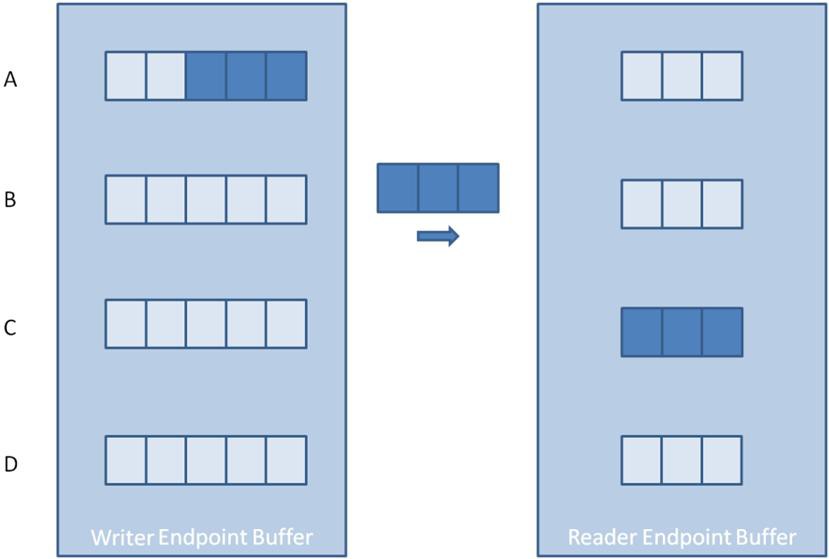
Failure to call flush before destroying the writer endpoint means any data in transit or any data still residing in the writer endpoint buffer could be lost. For this reason, National Instruments recommends that you call flush before shutting down the stream unless your application needs to cease communications immediately and you do not need any data that might be lost in the process.
Once destroy has been called on the reader endpoint, any subsequent write calls from the writer endpoint will result in an error. When the writer endpoint has been destroyed, subsequent read calls from the reader endpoint will continue to succeed until the reader endpoint buffer is empty, at which point, read calls will return errors. If a multiple element read request is received for more elements than remain in the buffer, the read request will return whatever elements are remaining in the buffer, and subsequent read requests will throw an error. This is the only case where a multiple element read request will return fewer points than requested without also indicating a timeout or error condition.
Properties
Network streams have a number of properties available that the application can monitor to obtain information about the ongoing data stream. A few of these properties are explained in more detail below. For information on the remaining properties, see the Network Streams Endpoint Properties page in the LabVIEW help.
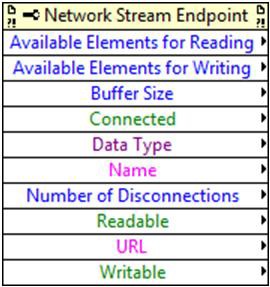
Available Elements for Reading is used by the reader endpoint to return the number of unread elements that reside in the endpoint buffer. This is useful for determining reader endpoint buffer utilization and will only return valid results when read from a reader endpoint. Similarly the "Available Elements for Writing" property returns the number of unwritten elements that reside in the endpoint buffer and can only be read by the writer endpoint. It is often useful to monitor buffer utilization while prototyping applications in order to see how well the reader and writer are keeping up with each other. This information can be used to determine bottlenecks in the application and to fine-tune the endpoint buffer sizes so that the minimum amount of memory resources are consumed while still meeting the overall throughput requirements for the application.
The Connected property indicates the status of the network connection between the reader and writer endpoints. A false on the connected property either indicates that the other endpoint was destroyed using the Destroy Stream Endpoint function or that there is a disruption in the network connection between the two endpoints. In the case of a network disruption, the endpoints will continually try to reconnect in the background until the disruption is resolved or until the endpoint is destroyed.
Number of Disconnections returns the number of times the network connection between the reader and writer endpoints has been disrupted due to problems in the network or from the remote endpoint being destroyed. This property in conjunction with the Connected property can be used to determine the general stability and health of the network connecting reader and writer endpoints.
Lossless Data Transfer and Flow Control
As has been mentioned previously, network streams provide a point-to-point communication channel that preserves all written data until it has been read from the stream or until the stream is destroyed. This lossless data transfer is accomplished through the use of FIFO buffer policies on the endpoint buffers and through acknowledgement and flow control protocol messages. The FIFO buffer policies prevent the application containing the writer endpoint from overwriting data if it's trying to write data faster than the network can transfer it. The acknowledgement messages prevent data loss from network disconnections, and the flow control messages prevent the application containing the writer endpoint from overwriting data if it's trying to produce data faster than the application containing the reader endpoint can consume it. The following sequence diagram illustrates in greater detail how these messages are used to ensure lossless data communication.
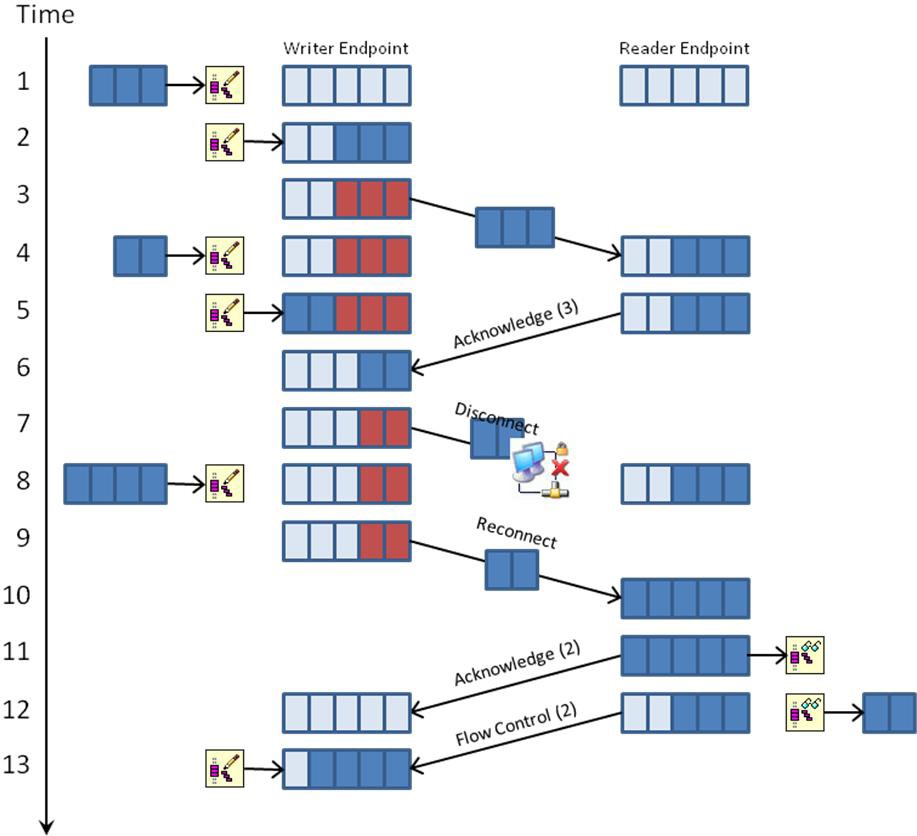
1. Time slot 1 shows a write request of three elements where both endpoint buffers are empty.
2. Because the writer endpoint can accept three elements without overwriting data, the write request completes, and the writer endpoint now contains three elements.
3. The writer endpoint sends three elements to the reader endpoint. At this point, the three elements within the writer endpoint are shaded red to indicate the elements are still occupied pending acknowledgement from the reader endpoint. Until an acknowledgement is received, the writer must hold onto the three elements and can send at most two additional elements.
4. The reader endpoint receives three elements from the writer. A write request of two elements is made on the writer endpoint.
5. The reader endpoint sends an acknowledgement of three elements. Since the writer endpoint can accept two elements without overwriting data, the previous write request from time slot 4 completes, and the writer now contains five elements.
6. The writer endpoint receives an acknowledgement of three elements. It removes three elements from its endpoint buffer, and it now contains two elements.
7. The writer endpoint sends two elements to the reader endpoint. However, in the middle of transmission, there is a network disruption and the data is never received by the reader.
8. A write request of four elements is received. Since the writer endpoint can only accept three elements without overwriting data, the write call blocks.
9. The stream has repaired the network connection and detects that two elements were sent that were never received. These elements are resent as part of the reconnection process.
10. The two resent elements are received by the reader endpoint. The reader now contains five elements and is full. The writer can't send any more elements until data is read from the reader endpoint.
11. The reader endpoint sends an acknowledgement of two elements. At the same time, a read request for two elements is received.
12. The writer endpoint receives an acknowledgement of two elements and removes them from its endpoint buffer. The writer is now empty. Since the reader has five elements, it completes the previous read request of two elements and sends a flow control message of two elements to the writer endpoint to let it know it can accept an additional two elements without incurring an overflow. The reader now contains three elements.
13. Since the writer now has five free elements, it completes the write request from time slot 8 that has been blocked. The writer now contains four elements. In addition, it receives the flow control message of two elements from the reader. It can now send at most two additional elements to the reader until additional flow control messages are received.
Connection Management and Reconnections
In the previous section we showed how network streams preserve lossless data transfer even in the event of connectivity problems with the underlying network. This section will discuss in more detail how this reconnection process is managed.
In any given network stream, one of the endpoints is designated as the active endpoint, and the other endpoint is designated as the passive endpoint. The active endpoint is the endpoint that originates the initial network connection and is responsible for actively trying to reestablish the connection whenever it detects the network status has become disconnected. Conversely, the passive endpoint is the endpoint that listens or waits to receive a connection request. In terms of client/server terminology, the active endpoint is synonymous with the client, and the passive endpoint is synonymous with the server. The create endpoint function designates which endpoint is the active one. The endpoint that specifies the URL of the remote endpoint it wants to connect to is designated as the active endpoint, and the endpoint that doesn't specify a URL for the remote endpoint is designated as the passive endpoint.

In the picture above, the writer endpoint on the left is the active endpoint since it specifies the URL of the reader endpoint it's connecting to. On the other hand, the reader endpoint on the right is designated as the passive endpoint since it doesn't specify the URL of the endpoint it's connecting to. If both endpoints specify the remote endpoint they're connecting to, the endpoint that gets designated as the active endpoint is not deterministic and will depend on the order in which protocol messages are transmitted and received on the network.
In the event of a disconnection, the active endpoint will continuously try to reestablish communication with the passive endpoint in the background. This background process will continue until the connection is repaired or until the endpoint is destroyed. While in the disconnected state, writes to the writer endpoint will continue to succeed until the writer is full, and reads from the reader endpoint will continue to succeed until the reader is empty. Once the writer is full or the reader is empty, read and write calls will block and return timeout indicators as appropriate. However, no errors will be returned from the read or write call itself.
While the endpoint buffers provide some level of protection from jitter due to unreliable networks, they will eventually fill up or empty if the network remains disconnected for too long. If your application needs to tolerate long network outages, you should either size your endpoint buffers to absorb the largest amount of downtime expected or implement appropriate logic to handle timeout conditions in a disconnected state. Also, although a stream is able to recognize it's in a disconnected state, it can't always differentiate whether the disconnection is the result of a network problem or an application crash or hang from the application containing the remote endpoint. In the case of a crash or hang, if the endpoint that crashed was the active endpoint, the passive endpoint that is still running will wait forever to receive a reconnection. Since the remote application is no longer responding, this message will never arrive, and the local application will make no further progress with the stream connection. If your application needs to tolerate and recover from crashes or hangs in the remote application, it's recommended you implement your own watchdog timer by periodically checking the Connected property and taking appropriate action if you are unable to reestablish communication in a reasonable amount of time.
weatherburnalaing.blogspot.com
Source: https://www.ni.com/en-id/innovations/white-papers/10/lossless-communication-with-network-streams--components--archite.html